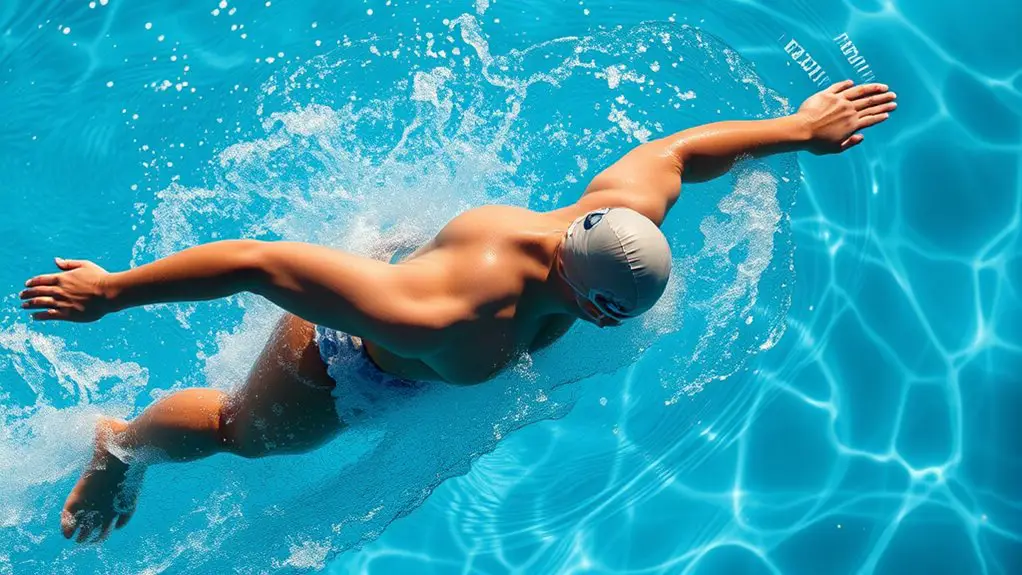Flexibility plays an essential role in your stroke efficiency while swimming. It enhances your range of motion, allowing smoother movements that reduce water resistance. Improved flexibility also boosts your technique, enabling you to generate more power with less effort. You'll find that as you become more flexible, your strokes become more fluid and effective, leading to a more enjoyable swimming experience. There's plenty more to uncover about maximizing your swimming potential through flexibility.
Understanding Stroke Efficiency in Swimming
Stroke efficiency in swimming is all about how effectively you move through the water with minimum effort. To achieve this, you need to focus on your stroke technique. Each movement should feel fluid and natural, cutting through the water rather than battling against it. When you perfect your technique, you reduce water resistance, allowing you to glide with ease.
Think about how your body interacts with the water. If you're fighting against resistance, you'll tire quickly and lose that sense of freedom you crave. Instead, aim for a streamlined position, engaging your core and aligning your limbs.
Practice makes perfect; the more you refine your technique, the less energy you'll expend. You'll find that each stroke becomes a powerful, liberating push, propelling you forward. Remember, the goal is to enjoy the water, so embrace the process of improving your stroke efficiency and feel the freedom it brings.
The Role of Flexibility in Swimming Performance
While perfecting your stroke efficiency is essential, flexibility plays a significant role in enhancing your overall swimming performance. A flexible body allows for smoother movements, reducing drag and improving propulsion. When you work on your flexibility, you're not just stretching; you're optimizing your swimming biomechanics.
Consider these benefits:
- Improved Range of Motion: Greater flexibility leads to a fuller and more effective stroke, allowing you to glide through the water effortlessly.
- Injury Prevention: Regular flexibility assessments can help identify tight areas, reducing the risk of injuries and keeping you in the water longer.
- Enhanced Power Transfer: Flexible muscles can generate force more effectively, translating into stronger strokes and better performance.
Key Areas of Flexibility for Swimmers
When it comes to swimming, flexibility in key areas is essential for your performance. You'll want to focus on shoulder mobility, as well as hip and ankle flexibility, to enhance your stroke efficiency. By improving these areas, you can optimize your movements in the water. Additionally, shoulder dislocates can greatly improve flexibility, allowing for a more effective range of motion during strokes.
Shoulder Flexibility and Mobility
Shoulder flexibility and mobility play an essential role in enhancing your swimming performance, as they directly impact your ability to execute efficient strokes. By maintaining ideal shoulder flexibility, you can reduce the risk of shoulder injuries and improve your overall technique. Consider incorporating these key elements into your routine:
- Mobility drills that focus on joint stability and posture alignment
- Flexibility assessments to identify areas needing improvement
- Warm-up routines that promote strength balance and prepare your shoulders for action
Integrating effective recovery techniques will also help you maintain your shoulder health and performance. By prioritizing shoulder flexibility and mobility, you'll guarantee you're swimming with freedom and efficiency, releasing your true potential in the water.
Hip and Ankle Flexibility
Hip and ankle flexibility are essential for swimmers looking to optimize their stroke efficiency and overall performance. With improved hip mobility, you can achieve a more streamlined body position, allowing for smoother gliding through the water. Ankle stability plays a vital role in maintaining proper kick technique, enhancing propulsion and reducing drag.
| Hip Mobility | Ankle Stability |
|---|---|
| Increases range of motion | Supports effective kicks |
| Enhances body rotation | Improves propulsion |
| Reduces injury risk | Maintains proper form |
| Boosts overall efficiency | Allows for better turns |
Benefits of Increased Flexibility in the Water
Increased flexibility in the water can greatly enhance your range of motion, allowing for smoother and more powerful strokes. This improvement not only leads to better stroke mechanics but also helps reduce your risk of injury. By focusing on flexibility, you'll find yourself swimming more efficiently and effectively.
Enhanced Range of Motion
Flexibility plays an essential role in enhancing your range of motion while swimming, allowing for smoother and more efficient strokes. With increased flexibility, you can perform dynamic movements that maximize your propulsion through the water. This improved range not only elevates your performance but also contributes to better joint stability, reducing the risk of injury.
- Facilitates a natural flow in your stroke technique
- Enhances your ability to stretch and reach for each stroke
- Promotes a more comfortable and relaxed swimming experience
Improved Stroke Mechanics
While you might not realize it, the mechanics of your stroke can greatly improve with greater flexibility in the water. Increased flexibility allows you to achieve ideal body position, enhancing your stroke timing and efficiency. When you're more limber, you can glide through the water effortlessly, creating a powerful and fluid movement.
Here's a quick look at the benefits of flexibility:
| Benefit | Description | Impact on Stroke |
|---|---|---|
| Enhanced Reach | Longer strokes with less effort | Improves stroke timing |
| Better Rotation | More fluid body movement | Enhances body position |
| Reduced Resistance | Streamlined entry and exit | Boosts overall efficiency |
Embracing flexibility releases your potential, liberating your strokes to flow freely and naturally.
Reduced Injury Risk
When you're more flexible in the water, you considerably reduce your risk of injury. Embracing flexibility isn't just about performance; it's essential for staying injury-free. By integrating effective injury prevention strategies into your routine, you can enjoy the freedom of movement without fear. Here are some benefits of increased flexibility:
- Enhanced range of motion, allowing for smoother strokes
- Improved muscle recovery through effective rehabilitation techniques
- Decreased strain on joints, reducing the likelihood of overuse injuries
These aspects come together to create an environment where you can swim freely and confidently. When you prioritize flexibility, you're not only improving efficiency but also ensuring longevity in your swimming journey. So, stretch it out and plunge into your potential!
Common Flexibility Limitations in Swimmers
Many swimmers encounter flexibility limitations that can hinder their performance in the water. These common limitations often show up in tight shoulders, stiff hips, and inflexible ankles. When you can't achieve the full range of motion, it can feel like you're fighting against your own body, making every stroke less efficient. Flexibility challenges like these can lead to poor body alignment, which affects your speed and power. You might notice that your glide suffers, or you struggle to maintain a streamlined position during your swims. Over time, these restrictions can even lead to discomfort or injury, holding you back from reaching your full potential. Embracing your body's need for flexibility is essential to releasing that freedom in the water. By recognizing these limitations, you'll be better prepared to address them, ultimately enhancing your overall performance and enjoyment of swimming. Additionally, prioritizing mobility training can significantly improve your range of motion and reduce the risk of injuries.
Effective Flexibility Training Techniques
When it comes to enhancing your flexibility for better stroke efficiency, incorporating dynamic stretching routines can warm up your muscles effectively. Don't overlook the advantages of static stretching, which can help improve your range of motion over time. Plus, yoga offers unique benefits that can enhance both your flexibility and mental focus in the water.
Dynamic Stretching Routines
Dynamic stretching routines are essential for enhancing flexibility and preparing your body for physical activity, especially in sports like swimming, where fluid movement is crucial. Incorporating these dynamic warm ups into your training can boost your performance and reduce the risk of injury. Here are a few effective flexibility drills you can try:
- Leg Swings: Swing your legs forward and backward, engaging your hip flexors and hamstrings.
- Arm Circles: Rotate your arms in large circles to open up your shoulders and upper body.
- Torso Twists: Twist your torso from side to side to warm up your spine and core.
Static Stretching Benefits
While dynamic stretching prepares your muscles for activity, static stretching offers significant benefits for flexibility and recovery. By incorporating static stretching techniques into your routine, you'll enhance your muscle elasticity and joint range of motion. This practice allows you to hold stretches for a longer period, letting your body relax and release tension. The benefits of flexibility you gain from static stretching can lead to improved stroke efficiency and overall performance in the water. Plus, it's an excellent way to wind down after intense training, promoting relaxation and helping prevent injuries. So, take the time to incorporate these techniques into your regimen, and enjoy the freedom of movement that comes with increased flexibility. Your body will thank you!
Yoga for Swimmers
Incorporating yoga into your training can further enhance your flexibility and overall performance in the water. By integrating specific yoga poses and breathing techniques, you'll not only improve your range of motion but also cultivate a deeper connection with your body. Here are some effective techniques to try:
- Downward Dog: This pose stretches your hamstrings and calves while promoting spinal alignment.
- Pigeon Pose: Opens up your hips, which is essential for an efficient stroke.
- Breath of Fire: A powerful breathing technique that energizes and increases lung capacity.
Embracing these practices can lead to greater freedom in your movements, allowing you to glide through water with ease and confidence. So, roll out your mat and immerse yourself in the benefits of yoga!
Stretching Routines for Enhanced Flexibility
How often do you think about incorporating stretching routines into your training? Embracing flexibility can release your full potential in the water. Start with dynamic warm-ups to get your muscles ready for action. Movements like arm circles and leg swings help increase blood flow and prepare your body for a swim.
After your session, don't skip post swim stretches. They're essential for recovery and maintaining your range of motion. Focus on stretches that target your shoulders, back, and hips—key areas for swimmers. Additionally, incorporating mobility training into your routine can further enhance your movement efficiency and overall performance in the water.
Incorporating Flexibility Training Into Swim Workouts
After you've established a solid stretching routine, think about weaving flexibility training directly into your swim workouts. This integration not only enhances your stroke efficiency but also amplifies the flexibility benefits you've already cultivated. You'll feel more fluid in the water, allowing you to glide with ease.
Consider incorporating these stretching techniques during your swim sessions:
- Dynamic stretches before diving in to warm up muscles and increase blood flow.
- Active recovery with gentle stretching between sets to maintain flexibility and prevent stiffness.
- Focused cooldowns post-swim, emphasizing deep, static stretches to enhance recovery and flexibility.
Monitoring Progress in Flexibility and Stroke Efficiency
As you work on improving your flexibility and stroke efficiency, it's vital to monitor your progress to guarantee you're on the right track. Regular flexibility assessments can help you identify areas that need attention and track your improvements over time. Consider incorporating specific stretches or mobility exercises into your routine and evaluate how they affect your stroke mechanics. Additionally, paying attention to post-workout stretching can further enhance your flexibility and overall performance in the water.
Progress tracking is essential; keep a journal or use apps to document your flexibility gains and swimming performance. Note how changes in your flexibility translate into smoother, more efficient strokes. Celebrate small victories along the way, as they'll keep you motivated and remind you of how far you've come.
Success Stories: Swimmers Who Improved Through Flexibility Training
Many swimmers have experienced remarkable improvements in their performance thanks to dedicated flexibility training. You might find inspiration in their success anecdotes, showcasing the flexibility benefits that come from a commitment to stretching and mobility work.
- Increased range of motion, allowing for smoother strokes
- Enhanced muscle recovery, reducing the risk of injury
- Improved breathing technique, leading to better endurance
These stories highlight how flexibility training can release your potential, making every stroke feel effortless. Swimmers like Michael Phelps have shared their journeys, emphasizing how regular stretching routines transformed their performance. As you embrace flexibility, you'll likely notice how it not only enhances your swimming technique but also grants you the freedom to explore new limits in the water. Strong core muscles are also crucial for maintaining stability and control in your strokes, ensuring that flexibility training complements your overall performance. So, don't underestimate the power of flexibility training—it's a key ingredient in achieving your swimming goals!
Frequently Asked Questions
How Does Flexibility Impact Injury Prevention in Swimmers?
Flexibility plays an essential role in injury prevention for swimmers. When you're more flexible, you can move through a greater range of motion without straining your muscles. This flexibility benefits your overall performance and helps reduce the risk of injuries. Plus, if you do get injured, being flexible can aid in injury recovery, allowing you to bounce back more quickly. So, embracing flexibility can really give you the freedom to swim at your best!
Can Flexibility Training Replace Strength Training in Swimming?
Flexibility training can't fully replace strength training in swimming. While flexibility benefits your range of motion and helps prevent injuries, strength training builds the power needed for effective strokes and speed. You need both to reach your potential. Think of flexibility as enhancing your movements, allowing for smoother shifts in the water, but without the strength, you might struggle with endurance and performance. Embrace a balanced approach for the best results!
What Age Should Swimmers Start Flexibility Training?
You should consider starting flexibility training for swimmers as early as their pre-teen years. At this age, incorporating youth training and flexibility techniques can set a strong foundation for their development. By focusing on flexibility early, you're not just enhancing their range of motion; you're also promoting a sense of freedom in their strokes. It's all about helping them move fluidly and efficiently in the water as they grow and progress.
Are There Specific Diets to Enhance Flexibility in Athletes?
Did you know that around 40% of athletes don't prioritize their diets, despite its impact on performance? To enhance flexibility, you can adopt nutritional strategies like incorporating omega-3 fatty acids and antioxidants. These can support joint health and reduce inflammation. You might also consider specific dietary supplements, such as collagen, which can improve connective tissue health. Remember, fueling your body properly allows you the freedom to move more fluidly and perform at your best!
How Frequently Should Swimmers Reassess Their Flexibility Progress?
You should reassess your flexibility progress regularly to stay on track. Aim for flexibility assessments every 4 to 6 weeks; this gives you enough time to notice improvements without losing motivation. By keeping up with progress tracking, you can adjust your routine as needed and guarantee you're meeting your goals. Staying flexible not only enhances your performance but also gives you the freedom to enjoy your swimming experience even more.




